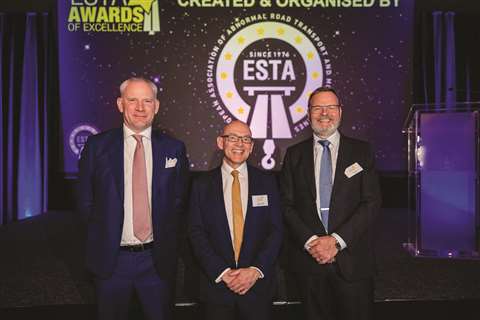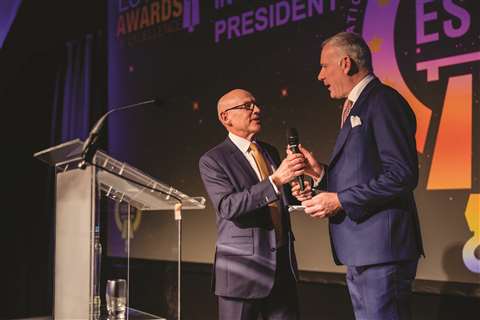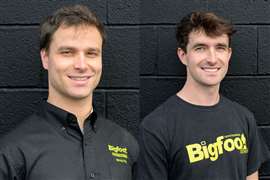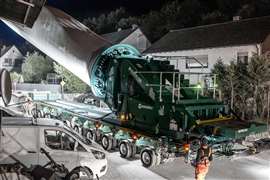Interview: former president of transport and crane association ESTA
25 August 2022
David Collett reflects on his nine years as president at the European industry association ESTA and considers what the future might hold
David Collett is well known as immediate past president at European transport and crane association ESTA. He is also managing director at UK heavy transport specialist Collett & Sons.
 Collett, centre, flanked by incoming ESTA president Fabio Belli, left, and Ton Klijn, ESTA director. (Photo: ESTA)
Collett, centre, flanked by incoming ESTA president Fabio Belli, left, and Ton Klijn, ESTA director. (Photo: ESTA)
A couple of months ago he handed over the ESTA presidency to Fabio Belli, CEO at Fagioli in Italy. Since then, he has had some time to reflect on his tenure.
Without further ado, David Collett gets straight into it. “Let me start by saying that serving as ESTA president for three terms – for a total of nine years and the maximum allowed under our rules – was a huge privilege and, it should be said, great fun.
Of course, I am not leaving the stage, as it were, and I will still sit on ESTA’s board.
How has ESTA improved the crane industry?
At the end of my period as president I thought it worthwhile to reflect on how much ESTA has progressed in recent years, on the challenges ahead – and to restate why I believe being involved with ESTA is so valuable, in the hope that it will persuade more people and companies to follow suit and get stuck in.
The starting point for me was the desire to try and improve conditions in the industry, changes that will benefit all of us. Topics at the top of the list are safety and harmonising international standards, along with related issues of efficiency, sustainability and technological developments.
To make changes of any type you have to influence your colleagues, the industry’s clients, our political leaders and regulators. But nobody will listen to you as an individual, you have to be part of a representative
group – an association – to have any clout. And as an international industry, that means being part of an international organisation.
Achievements as ESTA president
I first became involved with ESTA in 2006 at a meeting during the Intermat exhibition in Paris. The ESTA delegate from the UK’s Heavy Transport Association was retiring and I volunteered to take his place.
I had been active in the HTA – I was chairman for seven years – so I knew a little about ESTA. I joined the transport section and went along to my first meeting where I didn’t know anyone there except Dick Nooteboom [from trailer maker Nooteboom].
When I arrived, Dick said to me, ‘We are going to be electing a new transport section president and it is going to be you.’ He told me not to worry about anything as he would do all the talking! To this day, I don’t know why he picked on me, but I don’t regret it for one moment.
That evening, I went to my first ESTA social event, an awards dinner on a boat on the Seine. It was a complete sell out and I just got this fantastic feeling of friendship and fun – coupled with a great commitment to our industry. In the 15 years or so since then, we have steadily become more professional and extended our influence, but we have not lost our sense of fun and of being part of ESTA.
From my time as president, I think three achievements stand out where ESTA’s work is having a significant and important impact. They are the SPMT Best Practice Guide, the Best Practice Guide for the Transport and Installation of Onshore WTG Systems and the launch of the European Crane Operators Licence.
Of course, I can take little direct credit for any of these – the real credit goes to the volunteers who spend many hours working on these projects and to ESTA director Ton Klijn.
What is more, our work is never finished. For example, we are now planning to update the SPMT BPG and investigating whether we can create an SPMT operators’ licence using an ECOL-style model, something I am 100 per cent behind.
Why am I so proud of the SPMT guide? At a conference some years ago, a client stood up and questioned why there were so many SPMT incidents, even though it appeared that the rules were being properly followed.
The issue was the elephant in the room. It was obvious that the industry had a problem, but no-one was prepared to grapple with it, or knew how to tackle it. ESTA set up a working group and started looking in detail at how we could deal with the issue and what we might do differently.
ESTA’s SPMT best practice guide
It was a great example of the value of ESTA’s work – people inside the industry, who understand it well, coming together to shed light on, and hopefully solve, a problem for the benefit of everyone.
 David Collett, left, handing over the presidency of ESTA to Fabio Belli, Fagioli CEO, in April 2022. (Photo: ESTA)
David Collett, left, handing over the presidency of ESTA to Fabio Belli, Fagioli CEO, in April 2022. (Photo: ESTA)
To underline its impact, I had a couple of small companies contact me the other day whose clients – two big energy firms – said they would expect them to follow the procedures and recommendations as set out in ESTA’s SPMT best practice guide.
We are having a positive impact, even if our work often takes more time to bear fruit than we would ideally like.
As an aside, one point worth stressing when you look at incidents in the industry, is the fact that the overwhelming majority are caused by operator error and not mechanical failure, which underlines why training standards such as ECOL are so important.
Our best practice guides are all tremendous achievements but, in a way, they show both ESTA’s great strength and the limitations of our current structure as we look to the future.
One of our major assets is that the people involved have what I believe is the right mentality. They are people who care about our industry and they are people who are actually doing the job.
The reason that we are all involved is that ESTA gives you the opportunity to see how others are solving problems and you might learn ideas and practices you can use.
ESTA’s reliance on volunteers is, however, both a blessing and a curse. The downside is that everyone has their own business to run and that can make getting people to commit difficult and slow.
Understanding the crane industry
We should not underestimate the upside – that the people involved and taking decisions are industry insiders, who understand the practicalities and issues we are facing.
Going forward we will have to consider carefully how we want to develop. We are punching well above our weight but for the future, for ESTA to be even more effective and influential, we are going to need more paid staff and more administrative support.
Our current structure, excellent as it has been, can only take us so far. To be an effective lobbying organisation, we will need more full-time resources, and that means finding additional funds, whether that be through increased membership.
In many ways, ESTA has been a victim of its own success. My predecessor as president, the late and much-missed Christian-Jacques Vernazza of Mediaco in France, was instrumental in creating ESTA as a fantastic meeting place for the industry where we could network, share best practice and look at ways to improve safety.
He was one of a select group of people that laid the foundations essential for building ESTA up to its current position and he possessed the charisma and ability to unite people as if they were a true family.
Since then, and thanks to CJV, we have been steadily building on those foundations, increasing ESTA’s influence and impact. The question for us now is how we manage ESTA for the challenges we will face in the future. We have a strategic review coming up and I am sure this will be a subject that will figure in those discussions.
It will be difficult finding the right staff – we will need people that really understand the industry and are – or have been – a part of it, to ensure we maintain that exceptionally close connection between the association and the industry it serves. That will not be easy.
What are the benefits of ESTA membership?
People often ask me what is the benefit to my company of me being active in ESTA? The answer is simple. It has greatly increased my company’s international profile, given me an absolutely first-class networking opportunity and been a huge contributor to our process of continual improvement.
So, what would I say to non-members? If you want the opportunity to network, to learn from your peers, to make excellent contacts and – above all – if you are interested in the industry as a whole and how to improve it, then you should be active in ESTA.
For my successor, Fagioli’s Fabio Belli, the big immediate issue is going to be handling the fall-out from the war in Ukraine. Longer term it will be to decide how ESTA should grow and develop – and how it will deliver on the issues that matter to our members and the industry at large.
Looking forward it is clear – and I speak as a pro-European Englishman – that European and international co-operation has never been so important, and not just to improve our industry’s safety, efficiency and environmental performance.
The message is simple: Together we are stronger. It is something we forget at our peril.
STAY CONNECTED


Receive the information you need when you need it through our world-leading magazines, newsletters and daily briefings.
CONNECT WITH THE TEAM










